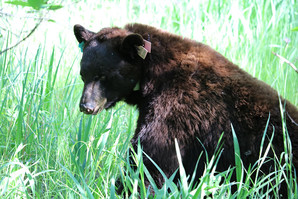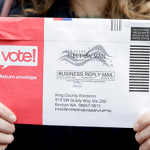The Minnesota bear hunting season opens Tuesday, Sept. 1, and the Department of Natural Resources is asking hunters to avoid shooting marked research bears. These bears are marked with distinctively large, colorful ear tags and have radio collars.
Researchers with the DNR are monitoring about 20 radio collared black bears across the state, especially in bear hunting zones 27, 25 and 45, and in parts of the no-quota zone. Most of them are in or near the Chippewa National Forest between Grand Rapids and Bigfork. Others are near Voyageurs National Park or around Camp Ripley.
“We’re asking hunters to avoid shooting these valuable research bears. These collared bears give us much of the data we use in bear management,” said Dave Garshelis, DNR bear research scientist.
A key to the research is looking at year-to-year changes in natural food supplies and how that affects individual bears in terms of their habitat use, physical condition, denning, reproduction and interactions with people. This research is not designed to evaluate mortality from hunting. Trapping new bears every year to replace the ones killed cannot substitute for long-term data on individuals.
Most of the collars have GPS units. The GPS coordinates are either uploaded to a satellite, or stored in the collar and downloaded by DNR researchers when they visit the bears in their dens. Each bear provides several thousand data points per year.
The bear’s coat often hides the collar, especially in the fall, and most of the collars are black. But all collared bears have large (3 by 2 inch), colorful ear tags so hunters can simply identify a collared animal by these large tags, whether or not a collar is visible. The tags should be plainly visible when a bear is at a bait, or on trail cam photos.
Photos of collared research bears and some research findings gained from them are available on the DNR website at mndnr.gov/bear.
DNR officials recognize that a hunter may not be able to see a radio collar or ear tags in some situations. For this reason, taking a bear with a radio collar is legal; however, waiting a few minutes to get a clear view of the bear’s head would reveal whether it has large ear tags, which indicates that it is collared. Bears with small ear tags (1 by 1/4 inch) are not collared but are important for other ongoing research projects. It is OK to take a bear with these small ear tags; if a hunter does take a bear with a small ear tag, they should report it as they would with any collared bear.
Any hunters who do shoot a collared bear should bring the collar to a bear registration station and call the DNR Wildlife Research Office in Grand Rapids at 218-328-8879 or 218-328-8874 to report shooting a collared bear.
Most collared bears have a small implanted heart monitor under the skin on the left chest. It looks like a small, silver capsule that is approximately the width of a paper clip. This contains valuable information stored in memory. Hunters who find this device while skinning the bear should leave it with the collar. Hunters with trail cam photos of ear tagged bears are asked to email the photos and locational information (nearest town or GPS coordinates) to mnbearcams.dnr@state.mn.us.
Last modified: 08/18/2020











